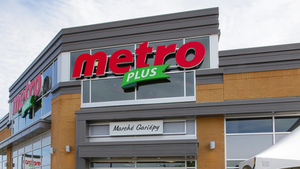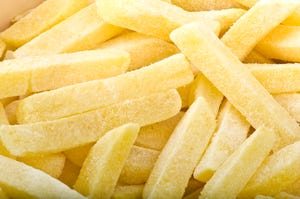THE INCREDIBLE BULK
Retailers are increasingly turning to bulk food merchandising as a way to give customers more attractive prices and greater variety.There's been a dramatic increase of bulk food sections in supermarkets in the past seven years, according to Beth Petrillo, vice president of sales and marketing at Trade Fixtures, Little Rock, Ark., a major supplier of the fixtures that are used to merchandise unpackaged
February 2, 1998
MARYELLEN LO BOSCO
Retailers are increasingly turning to bulk food merchandising as a way to give customers more attractive prices and greater variety.
There's been a dramatic increase of bulk food sections in supermarkets in the past seven years, according to Beth Petrillo, vice president of sales and marketing at Trade Fixtures, Little Rock, Ark., a major supplier of the fixtures that are used to merchandise unpackaged food. Supermarkets account for about 70% of Trade Fixtures' business, said Petrillo.
While the bulk food business slowed in the 1980s, it is now a high-growth area, especially for products like candy, coffee and natural food, said Petrillo.
Supermarkets are looking to bulk to compete with natural-food stores and supermarkets like Whole Foods Market and Wild Oats Markets.
While retailers share some basic merchandising strategies in creating their bulk food sections, they differ in many areas as well.
For example, while most retailers SN polled use at least three different types of bins in their bulk sections, they differ in how large the sections are, where they are located in the store, what kinds of items are stocked, and how often bulk is promoted.
Raley's Supermarkets, West Sacramento, Calif., and its Bel Air Markets division, Sacramento, Calif., use a combination of bulk food bins in the natural-food departments, including gravity feed, plexiglass, and deli-style bins with scoops, said Anne Edey, buyer/merchandiser for specialty and natural food. Most of its sections are about 16 linear feet, but some range from 12 to 24 feet.
"We have a full array of products," she said, "including candies, nuts, grains, dried fruit and flowers, beans, trail mixes and cookies."
Edey said her stores have been carrying bulk for at least 15 years, and that the department is a destination stop for some people. She also noted that the section attracts new customers and is a point of difference.
Harris Teeter, Charlotte, N.C., uses custom-built fixtures that hold acrylic bins, according to Chuck Corbeil, director of marketing for the chain. Bulk food in selected stores may include coffee, candy, natural-food and pet categories.
The size of the section varies by store, noted Corbeil, and can be anywhere from a 4-foot to a 100-foot set. The fixtures generally have four sections of stacked products.
Harris Teeter has been merchandising food in bulk for about 10 years. The stores use overhead signage, shelf signage and product labels and tags on individual bins as part of its program.
Central Market, a natural-food store in Austin, Texas, which is part of H.E. Butt Grocery Co., San Antonio, began merchandising food in bulk about three years ago, according to Jane King, bulk food manager.
Its bulk section carries almost 600 items and is located in the center of the store. Products merchandised in four different kinds of fixtures -- gravity-feed bins, acrylic bins, liquid dispensers and bucket bins -- include coffee, rice, flour, grains, snacks, trail mixes, sugar, granola, pasta, nut butter, maple syrup, tea, nuts, dried fruits and candy.
The section has been so successful that a second H-E-B unit in San Antonio, which was given a natural-food makeover, opened a bulk food section in January.
Wild Oats Markets, Boulder, Colo., also uses a variety of bins, including portable bins that allow stores to rotate where they merchandise certain items. For example, candies and nuts might be moved to produce and merchandised with shelved nuts and dates during the holiday season, explained Dale Kamibayashi, director of grocery purchasing.
Depending on how large the store is, the bulk department can occupy anywhere from 24 to 48 feet, with additional islands of solid food or liquids, such as oils, sweeteners, honey, maple syrup and tamari.
Standard bulk items include grains, flours, legumes, granola and cereals. Some nonfood bulk items at Wild Oats are detergents, dishwashing soaps, nonchlorine bleach and other cleaners. There are even bulk items in the body care section of the store, which offers shampoos and lotions that people can dispense.
Huckleberry's, a two-unit retailer owned and operated by Rosauers Supermarkets, Spokane, Wash., has freestanding bulk sections, with about 500 bins filled with grocery items, coffees and teas, and spices. The sections are about 1,000 square feet, according to Norm Carpenter, director of marketing and operations for Huckleberry's.
"We use gravity feed on a number of items, and a number of 20-pound plexiglass bins. We also have plastic, quart- and gallon-size glass jars," he said.
Mark Fleskes, produce manager for Lamb's Wilsonville Thriftway, Wilsonville, Ore., said his bulk sections are about 30 feet long by 8 feet wide, with about 100 bins. The bulk section, mostly candy and snack items, can be found in the produce department.
Retailers noted that bulk food merchandising appeals to customers for a number of reasons. First, bulk offers significant savings over packaged goods. Second, bulk is appealing to the eye when it is properly displayed, and it gives customers a choice about the quantity they would like to buy.
Socially conscious shoppers wish to lighten the environment's garbage load, so they like to buy products without extra packaging.
King of Central Market agreed that prices on bulk are significantly lower than those on comparable packaged items, and store margins are also respectable.
Fleskes at Lamb's saw bulk foods as a good secondary way to get sales, but said: "Never give up packaged items in lieu of bulk."
Retailers, for the most part, carry the same or comparable items in both bulk and packaged format, but King said that the bulk section sometimes wishes to stress a point of difference and will stock unique items that are not available in a package.
Universal to all retailers is a concern that unpackaged food remain sanitary and that it have an attractive presentation.
"Cleanliness sells bulk," noted Eric Rivkin, president of New Leaf Designs, Eden Prairie, Minn. Rivkin's company puts a lot of effort into designing bins that are easy to clean and that minimize the opportunity for bug infestation.
According to Rivkin, customer education should be at the top of the bulk food manager's list of priorities, along with rotating stock and ensuring that fixtures are clean and user-friendly. "Signage should tell customers what you expect: don't handle the food; use utensils; do not snack from the bin; close the lid and put the utensil back," Rivkin said.
All the retailers polled have a sanitation program that involves removing bins and cleaning them with soap and/or sanitizers and water. Most bulk departments had replacement bins, so that they could immediately restock items while the old container was being washed.
Scoops and disposable gloves are available in bulk departments.
About the Author
You May Also Like




